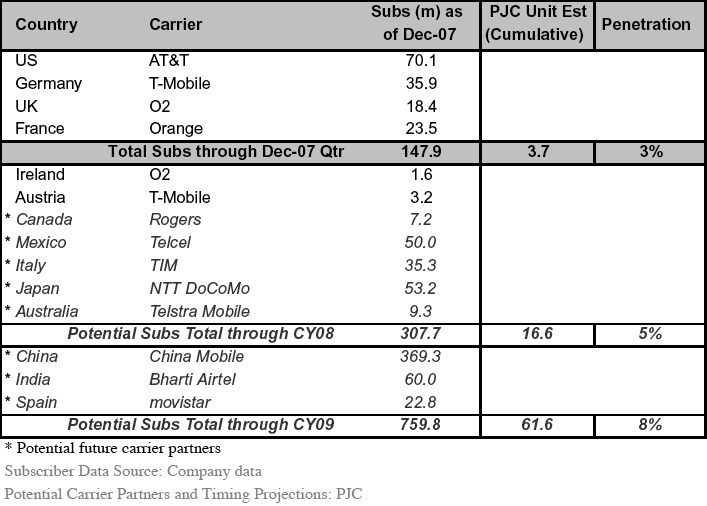Sub-$300 iPhone, 3G model seen driving 45M unit sales in 2009
Investment bank Piper Jaffray is out with a bullish research note on Apple today predicting a diversification of the iPhone line into a multi-tiered family of handsets that will combine for sales of 45 million units next year.
"While most investors view our estimate of 45 million iPhones in 2009 as outrageously aggressive, we are maintaining our estimate based on several factors," Munster wrote. "First, we expect Apple to introduce a 3G iPhone model with additional features in the next 3-6 months. We also expect Apple to offer an entire family of iPhones by January 2009 at the latest including lower priced models that decrease the average selling price (ASP)."
More specifically, the analyst expects a 3G model to arrive in June followed by a "perhaps more significant" introduction of a model by next year that will be priced between $200 and $300, addressing a more price sensitive market. As such, he expects iPhone ASPs to drop from $489 in 2007 to $365 in 2008 to $314 in 2009.
This pattern would mirror the path taken by Apple as it matured the iPod family, he said, where a slow by steady diversification saw the company enter lower price points with every new revision of the player. However, he noted that the iPhone's unit growth curve stands to be significantly steeper than the iPods, given that Apple sold more iPhones in the first two days of sales than it did in the first three quarters of iPod sales.
"And the company did not sell over 2 million iPods in a quarter until the iPod's third year of sales, whereas the company sold over 2m iPhones in the second full quarter of sales," Munster added. "In sum, we believe the iPhone is a full 2-3 years ahead of the iPod in terms of its historical growth pattern."
Compared to iPod units, which grew a radical 409 percent between Apple's fiscal 2004 and 2005, the analyst is modeling iPhone units to grow slightly slower at 304 percent between fiscal 2008 and 2009, given some uncertainty as to how quickly the company roll out cheaper models.
Munster's estimates also take into account the continued international rollout of the handset, which he believes will double the addressable market for the device every year for the next two years. With 3.7 million units having been sold through December via 6 carriers (who combined for a subscriber base of 153 million), he estimates the iPhone's penetration into this addressable market to be just 3 percent.
One key component of the international iPhone rollout is of course China, where market dynamics complicate Apple's business model of exclusivity, leading the analyst to believe the company will likely need to alter its terms in order to launch the device in conjunction with a carrier like China Mobile that sports over 370 million subscribers.
"We have spoken with people close to China Mobile and our conversations lead us to believe that Chinese carriers are unlikely to sign a revenue sharing agreement with Apple," he wrote. "This is due in part because of the 70 percent market share enjoyed by China Mobile. The bottom line is that the mobile phone market is less competitive in China than it is in the US and Europe."
As a result, China Mobile appears unwilling to pay the monthly revenue sharing of approximately $15 per month which Munster estimates other exclusive iPhone carriers are currently paying Apple. In time, that may force the company to alter its strategy of signing exclusive revenue sharing agreements with its partners in Asia, which he believes will enable it to sell the iPhone in China by the middle of next year.
In support of this theory, the analyst pointed to recent comments from chief operating officer Tim Cook, who revealed at an investor conference last month that Apple is "not married to any business model" and is instead "married to ... shipping the best phones in the world."
In the event that Apple does forgo its present revenue share model and exclusive carrier relationships, it would likely seek a one-time subsidy from each carrier per iPhone sold.
"We believe the early hype surrounding the launch of the iPhone enabled Apple to garner steep revenue sharing agreements for the 'must have' device from the initial carriers like AT&T, O2, and T-Mobile," Munster said. "However, as the iPhone becomes an established player in the mobile phone market and competitive offerings become available, Apple may not be able to command the exclusive agreements with high revenue sharing plans as it did initially."
The Piper Jaffray analyst maintains a Buy rating and $250 price target on shares of the Cupertino-based Apple.
 Katie Marsal
Katie Marsal











 Wesley Hilliard
Wesley Hilliard
 Andrew Orr
Andrew Orr



 Amber Neely
Amber Neely

 William Gallagher
William Gallagher







